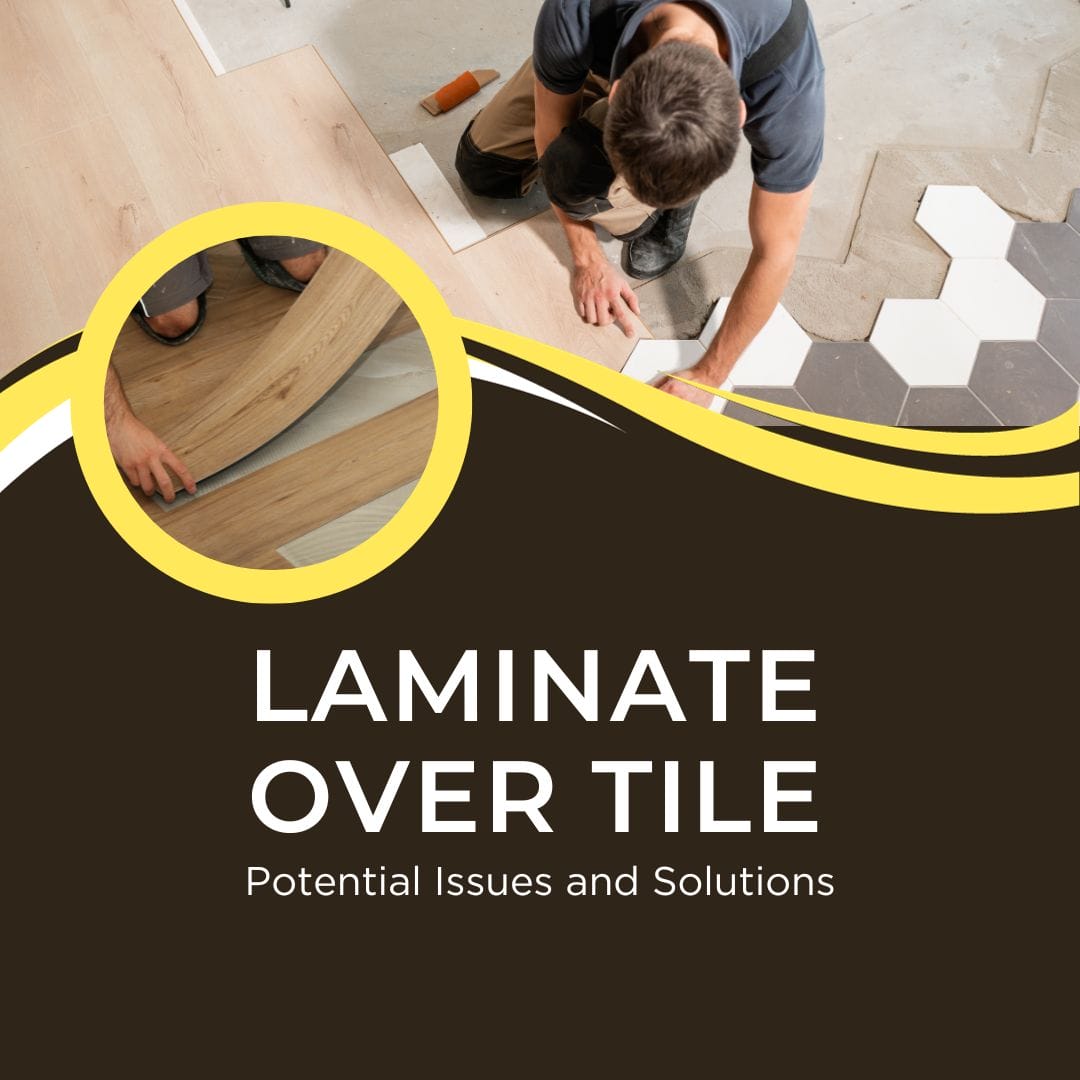Ceramic tiles may be good for aesthetics but are prone to cracking, breaking, chipping, and feeling cold. These factors discourage most homeowners from installing this flooring in their living spaces and bathrooms.
If you are a homeowner who has installed tiles in his house and are thinking about changing the floors into a better, more comfortable type of flooring, laminate planks, under your feet. But, the question is, can you install laminate flooring over ceramic tiles?
What is Laminate Flooring?
Laminate flooring is synthetically made from wood byproducts glued together with resins and a laminate process. They usually have a lifespan of more than 20 years, and they are more durable than ceramic tiles.
Learn about repairing chipped laminate flooring.
Can You Put Laminate Over Tile Problems?
No, you cannot install a laminate floor over ceramic tiles if they are not in good condition. Putting laminate flooring over an uneven or damaged tile floor can cause problems like buckling and chip after installation. For an even and durable structure, you must consider the floor’s height, cleanliness, and grout joints.
However, you can install laminate flooring over tiles that are not broken, chipped, or cracked. It will improve the feel and aesthetics of the floors. You can either float laminate planks over the tile floor or glue them down on the floor. However, you will have to install an underlayment that will work as a moisture barrier to prevent bubbling in planks.
Use the right cleaning methods to avoid damaging the laminate, especially by following guidelines on how to clean laminate floors without causing damage.
Factors to Consider When Laying Laminate Floors On Ceramic Tiles
Condition of the Tile Floor:
It is the first and most important factor to keep in mind when you install laminate flooring over ceramic tiles. If the tile floors are in bad shape, there will be more problems than what it is worth.
Ensure the tiles do not have cracks, deteriorated grout, deep crevices, or loose areas. However, minor issues can be repaired by something as simple as removing the entire floor. But, avoid installing the laminate floor over broken or loose tiles.
Laminate floors can be a cheaper and easier-to-install alternative to hardwood floors, and for maintenance tips, see how to clean and maintain laminate floors.
Levelness of the Tiles
The levelness of the tiles is another feature you need to account for the levelness of the tiles. If the tiles are uneven, lifting, or popping too much, the structural components and locking mechanisms will not be good enough for any type of floating floor. So, if tiles are unlevelled even by 1/16 inch, they need to be fixed before you install a laminate floor.
Floor Height
Most homeowners tend to ignore floor height even though it is one of the most important factors to consider. Installing laminate floors over the tiles increases the height of the floor. This increase in height might be insignificant, but it can get in the way of appliances, block doors, or lessen headroom in some areas.
Should You Remove Tiles Before Installing Laminate Flooring?
If the tiles are beyond repair, you should remove the tiles before installing a laminate floor to create a level base on which the floor will rest. If the tile floor has substantial depressions or is loose or damaged, they are the signs that you should remove them instead of installing a laminate floor over it.
You can easily fix minor problems like chipped tiles, insufficient grout or small irregularities. But some issues are difficult to fix and require more work than they are worth. In such cases, removing the tiles and proceeding with the project is better and simpler.
Cracks and Depressions:
If there are major cracks and depressions in several places, it might be a sign of even shifting in the foundation or an issue with the subflooring. Even though these problems don’t look significant, they can impact the stability of the floor you will install over it.
Grout
Degradation in grout is fine but check if the damage suggests shifting portions of the floor that are stretched, squeezed or folding the grout lines. These are the signs that you have to take out the tiles.
Loose Tiles
If some of the tiles are loose, there will be more tiles that may loosen over time. When this happens, tiles will not be good enough floor for the laminate planks. Also, if you install the planks over loose tiles, your laminate floor will be uncomfortable to walk on. So, it’s better that you just remove the tiles first.
Why Install Underlayment Under Laminate Flooring Over Tiles?
Underlayment is important in installing laminate over tiles, especially if the subfloor under tiles has an underlayment. Putting an underlayment provides several benefits like insulation, comfort, acoustics, and moisture protection.
Moisture
Moisture is the main reason why you should install underlayment beneath the planks. It acts like an adequate moisture barrier. Most underlayments are designed to prevent moisture in the subfloor from getting into laminate flooring. It protects from mold, warping, and other issues.
Insulation
Tile floors get cold in winters making your laminate floor cold too. Underlayment offers some insulation and keeps your floor warm without using a heater.
Acoustics
Underlayment improves acoustics and reduces echo in the area, which is a big plus for those who like their rooms snug and quiet.
Pros and Cons of Installing Laminate Floor Over Tiles
When planning to lay laminate over tiles, you should consider its downsides and advantages. Weighing these pros and cons will help you make a better choice that is more suitable for you.
Advantages
- You can install laminate over tiles even without any experience
- You will be able to save time on removing tile floor, which is not an easy task
- It will improve the aesthetics of your living space, Laminate floors are a good choice for small spaces like studio apartments, and for more tips on this, explore maximizing space and cleanliness in studio apartments.
- Laminate is durable and more resilient against certain damages
- It provides acoustics by reducing echos that are caused by hard surfaces
Disadvantages
- You cannot install laminate floor over damaged tiles
- Even small irregularities in the tiles can cause squeaking when you walk on laminate floor
- It raises the floor height, which can block doors and can come in the way of different things
- It is not as resistant to liquid and moisture damage as tiles
How to Install Laminate Over Ceramic Tile?
Items in You Need
- Hammer
- Rubber Mallet
- Utility Knife
- Pull Bar or Tapping Block
- Measuring Tape
- Straight Edged
- Speed Square
- Chalk Box
- Handsaw
- Pencil
- Laminate Planks
- Underlayment for Laminate
- Scrap Wood Spacers
- Tape
Acclimatize the Laminate Planks
Keep your laminate floorboards in their packaging and lay them in the room where you want to install them for about 48 hours to acclimatize the planks. You can read the manufacturer’s instructions to find out the correct recommended period.
When acclimatizing the laminate planks, ensure the room conditions are normal. The floorboards will not acclimate properly if the planks are exposed to fresh paint or wet plastering.
Replace the Damaged Tiles
Check the tiles and see if they are in good condition before you start installing the planks. If the tiles are loose or protruding, you must replace or fix them first to make the floor leveled and even, including addressing any laminate flooring scratches.
Replace any cracked, chipped, or broken tiles to avoid any problems in the future, such as bouncy or repairing damaged laminate floors.
Make the Floors Even
Level the uneven ceramic floors to ensure the laminate floorboards do not detach when you step on uneven parts. You can use different leveling compounds to level the tiles.
Install the Underlayment
Read the manufacturer’s instructions for the planks you bought to see which kind of underlayment is best suited. They provide better moisture protection, warmth underfoot, and heat insulation.
Underlayment can be a spongy plastic foam sheet between the actual laminate floor and the ceramic subfloor, but remember the importance of effective floor cleaning.
Installing Laminate Floorboards
Once the floor is uniform and smooth after installing the underlayment, you can proceed to install the laminate floorboards. The rows of laminate floorboards should have a sawtooth, staggered appearance for added structural strength and visual appeal, and for further guidance, refer to this laminate floor repair guide.
Use a tape measure to leave a 9.5-millimeter gap from the wall so that there is enough room for the laminate planks to expand.
Apply Sealant
Apply the recommended tile sealant to the floor to make a watertight finish.
Possible Problems Related to Installing Laminate Planks Over Tiles?
Though installing planks over ceramic tile is a good idea, you must be content with some issues. Especially bathrooms, which can be technical and costly to remodel because they require stronger underlayment and sealing of the seams.
Here are some problems you might face if you have installed laminate planks over tiles.
Hard Surface
Putting laminate floors over ceramic tile floors creates a hard surface that may not be comfortable for many homeowners. You can make the floor less hard by laying an underlayment form below the laminate flooring, but even that may not help reduce the floor’s hardness. To ensure stability and aesthetic appeal, lay the laminate in a staggered pattern, as explained in how to make a stagger pattern for laying laminate flooring
Slippery
Installing laminate floors over ceramic tiles can make the surface slippery, a safety hazard in your home, especially in the bathroom. In addition, the smooth surface it creates can cause accidents for those who walk on it.
To reduce slipperiness, you can consider installing floorboards with lower slippery indexes designed for high-risk areas such as showers and bathrooms.
Noisy
Another problem with installing planks over tiles is that they make snapping and popping sounds that make it uncomfortable to walk on.
Moreover, the residents’ weight and furniture will stress the grooves and interlocking mechanisms that make disturbing sounds.
Toxic Fumes
Some laminate floorboards have adhesives that may release toxic fumes, especially when new. Though the toxicity levels are low, you still will be exposed to chemicals and unhealthy gases such as formaldehyde, especially when the temperature rises.
You can consider installing ecologically friendly and low-impact products to avoid toxic fumes from the chemical adhesives.
Moisture Damage
When subjected to extreme cold, laminate floors attract condensation. The moisture due to condensation can move underneath the underlayment damaging the floorboards.
To avoid the warping and buckling of laminate flooring, you will need a strong waterproofing underlayment on your floor. But, these underlayments are made from a high-quality material, which can significantly increase costs.
Installation Cost
The laminate floor may be cheaper, but the installation cost is high. On average, installing planks over tiles can cost $3 to $5 per square foot. Add to this the installation cost, which is more than the installing other types of the floor over tiles.
Rises the Floor
Laminate and underlayment can raise the floor heights by half an inch or more which can be uncomfortable to walk on, and it will be quite visible in the doorways where the floor transitions to another type of floor.
You can solve this problem with some transition strips. Simply leave a small gap between the transitioning points and nail the strip, which will hide the height difference.


